Google Pixel 8a vs Pixel 6 Pro: Is the new phone a worthwhile upgrade?
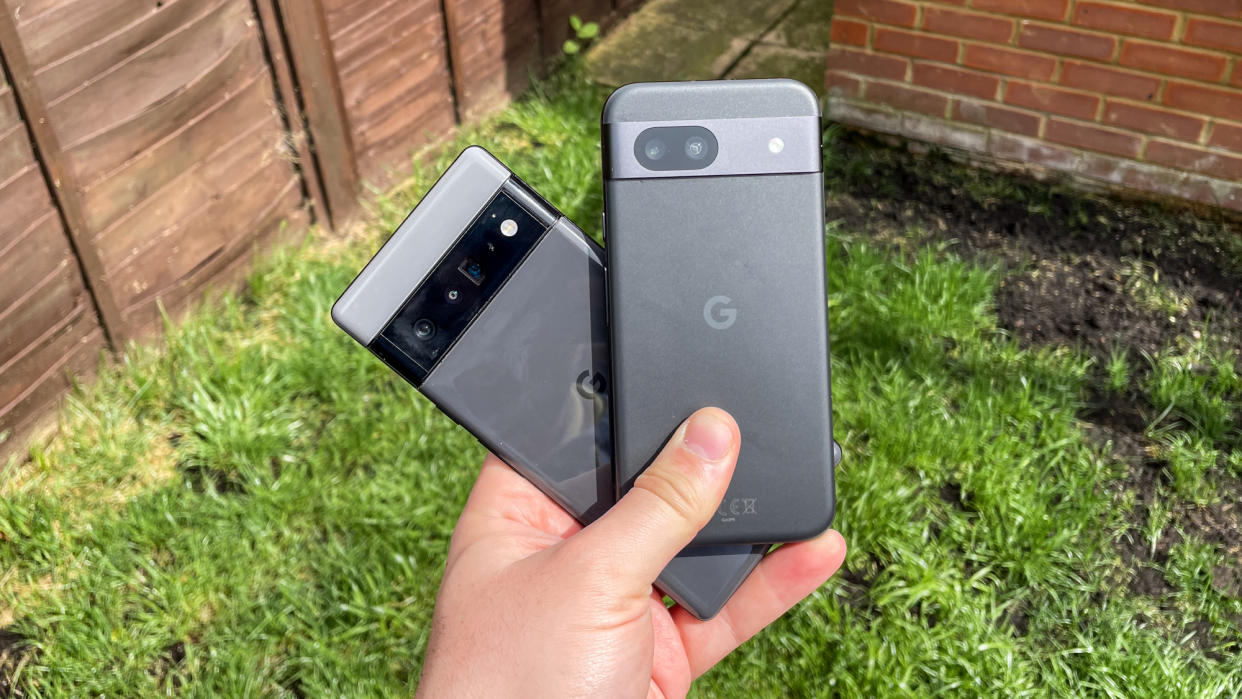
The Google Pixel 6 Pro was a great phone when it was released back in 2021, ushering in a new Pixel age as one of the first phones to come with a Google Tensor chipset. But that phone is getting older, and it’s set to lose access to Android updates at some point this October. That means you may be getting ready to upgrade.
The Google Pixel 8a has a lot more to offer than the Pixel 6 Pro, thanks to the Tensor G3 chipset and a myriad of additional hardware upgrades. It’s much cheaper and costs around half of what we expect the Pixel 9 Pro to cost when tht phone arrives later this year.. But is it worth upgrading to the Pixel 8a from the Pixel 6 Pro? Can the jump from a Pro model to an A series actually be called an upgrade?
To find out, we’ve put the two phones head to head to see just how a newer midrange model like the Pixel 8a compares to an older flagship. Here’s the Google Pixel 8a vs Google Pixel 6 Pro face-off to see which Pixel handset comes out on top.
Google Pixel 8a vs Pixel 6 Pro: Specs
Google Pixel 8a vs Pixel 6 Pro: Price
Back when it was new, the Pixel 6 Pro started at $899 for 128GB of storage and could cost as much as $1,099 for a model with 512GB of RAM. The Pixel 8a starts at $499 for a 128GB model, while a 256GB model is available for $559.
The Pixel 6 Pro can be bought for much less these days, but it’s the launch price that matters in this comparison. And that $400 price difference is quite a lot of money. It’s only $99 off the cost of a second Pixel 8a smartphone, assuming you’d have any interest in buying an extra phone for yourself or someone else.
Google Pixel 8a vs Pixel 6 Pro: Design & Display
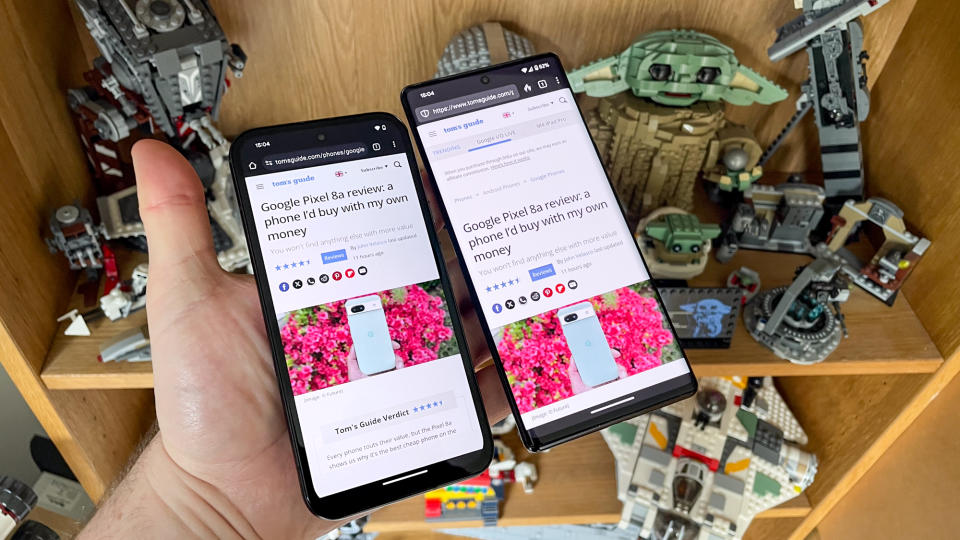
While similar in style, the Pixel 8a and Pixel 6 Pro do have a number of key design differences — least of which is the size. The Pixel 8a has a 6.1-inch display with 2,400 x 1,080 resolution and a 60-120Hz adaptive refresh rate — the same as the Pixel 8. Meanwhile the Pixel 6 Pro is larger, offering a 6.7-inch screen with 3,120 x 1,440 resolution and a 10-120Hz adaptive refresh rate.
The Pixel 6 Pro also has the advantage of having a display made of Gorilla Glass Victus, which is significantly more durable than the Pixel 8a’s Gorilla Glass 3. While no kind of glass is impervious to damage, Victus is more resistant to scratches and damage than its predecessors. The Pixel 6 Pro display also has a much thinner bezel, though this also comes with the dual-curved displays most phone companies have since scrapped.
Both Pixel phones have a full-length camera bar along their backs, with the Pixel 8a rocking a metallic bar and the Pixel 6 Pro utilizing one made entirely of glass. The whole back of the Pixel 6 Pro is glass, in fact, — it's also made from Gorilla Glass Victus — and there's a glossy two-tone color scheme. The Pixel 8a has a matte back made from a composite material which is arguably nicer to look at, while making it harder to see smudges and dust.
The Pixel 6 Pro hails from a time when straight edges and corner points were all the rage. However the Pixel 8a has a more rounded design that you may prefer the look of.
Another major upgrade for the Pixel 8a is the fact it comes with an Actua Display — with the same specs as the Pixel 8. Google claims that the display offers up to 1,400 nits of HDR brightness and a peak brightness of 2,000 nits. In our testing we found this display maxed out at 1,378 nits, or 1,350 nits when displaying HDR content. Surprisingly that’s slightly more than the Pixel 8’s reading — 1,349 nits in our tests.
The Pixel 6 Pro is nowhere near as bright. In fact our testing found that its peak brightness was a meager 842 nits. While that wasn’t too bad compared to its biggest rivals at the time of release, it’s seriously far behind the Pixel 8a, not to mention more current flagships. The Pixel 6 Pro display covers less of the color gamuts, with an sRGB score of 104% and DCI-P3 score of 74.3% — compared to the Pixel 8a’s 126.5% sRGB and 89.6% DCI-P3 results. To top it off, the Pixel 6 Pro's Delta-E rating of 0.3, compared to the Pixel 8a’s 0.24 shows that the Pixel 6 Pro has slightly worse color accuracy as well. (The closer to zero, the more accurate the colors on the display.)
Google Pixel 8a vs Pixel 6 Pro: Cameras
There are a lot of differences between A-series Pixel cameras and those found on the Pro. The latter has a telephoto lens, but the Pixel 8a benefits from 2.5 years of digital photography advances plus a serious resolution boost — not to mention upgraded Tensor G3 image processing and other software enhancements. But which Google phone actually produces the better photos?
At first glance, photos from the main camera lens of either device don’t seem all that different. The coloring and general quality looks pretty similar.
However closer inspection reveals that the Pixel 6 Pro isn’t producing shots that are quite as crisp. This is particularly apparent in the bottom left where the fencing meets the wall and on the tree leaves.
The ultrawide lens shots are pretty similar, too, though it’s more noticeable that the Pixel 8a has a much larger field of view than the Pixel 6 Pro. Specifically, you get 120 degrees with the Pixel 8a versus 114 degrees from the Pixel 6 Pro, allowing the Pixel 8a to pick up a lot more of the area. Visually , though, the cameras produce a very similar quality photo.
Unsurprisingly, the zoomed-in shoots are where the Pixel 6 Pro really gets to flex its hardware. While the 4x zoom on the telephoto lens isn’t perfect, things do come out clearer than with the the Pixel 8a, which has to rely on Google's Super Res Zoom feature.
Coloring is better on the Pixel 6 Pro and the distant features are slightly crisper, despite still being rather blurry. It seems there are benefits to having optical magnification on the telephoto camera, despite AI advancements.
The same is true for a shot taken at 8x magnification. While the details on the tower are much easier to make out, you can still see some blurring round the edges and on the grass. While the Pixel 8a seems to be much more accurately colored at 8x magnification, the details themselves are only marginally better than 4x — and significantly worse than the Pixel 6 Pro.
Like the ultrawide, the Pixel 8a has a much larger field of view on its selfie camera, letting you grab more from your surroundings (even if it's mostly just my arm in this shot). From a quality perspective, the self-portraits look pretty similar, as both cameras are able to pick up individual strands of hair, freckles and even some of the fluff on my shirt. The same goes for the bokeh effect: there’s very little distinguishing the two in the shot with the me popping out from the rest of the background.
The Pixel 6 Pro also seemed to produce better low light coverage, with the church and trees in the background appearing much crisper than what the Pixel 8a could produce. But at the same time, the street light came out looking like screen glare from a bad sci-fi movie in the Pixel 6 Pro shot, which is a lot more distracting than the Pixel 8a’s yellow blur.
Overall it seems as though the Pixel 8a comes out on top in the camera department, showing just how far Google’s mobile photography has come in the past 2.5 years. It’s only when zooming and shooting in low light that the Pixel 6 Pro managed to come out on top. So if camera performance is top on your list of upgrade priorities, the Pixel 8a wouldn’t be a bad choice.
Google Pixel 8a vs Pixel 6 Pro: Performance
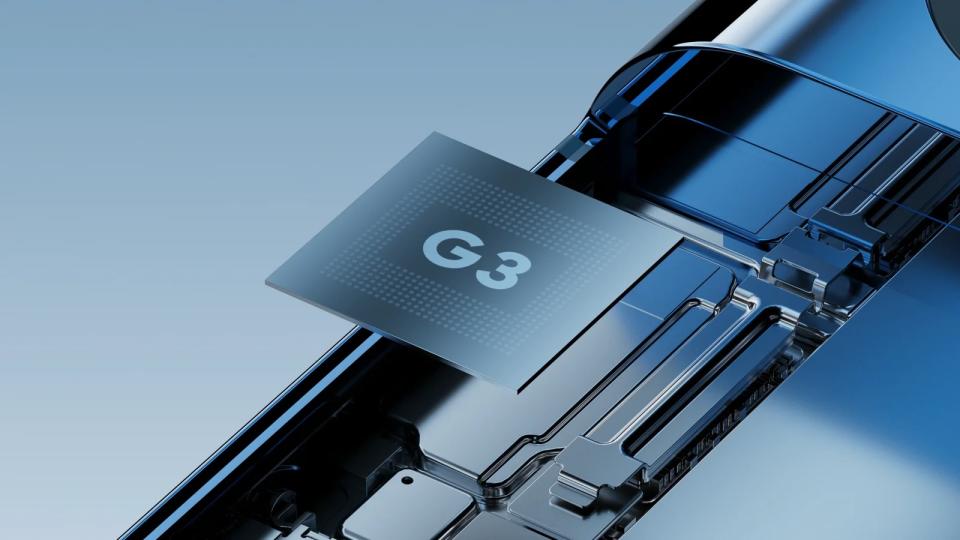
Seeing as how the Pixel 8a’s Tensor G3 chipset is two generations newer than the Tensor G1, you’d expect it to be quite a bit more powerful. And you would be correct. Normally the Tensor chips in A series Pixels aren’t quite on par with those in the standard and Pro models, but when you’re comparing a new midrange device to an older flagship, the new chip enjoys a distinct advantage.
A single-core Geekbench 6.3 benchmarking test saw the Pixel 8a come out with a score of 1,581, which is noticeably higher than the 1,185 scored by the Pixel 6 Pro. The multi-core test results are even more impressive, with the Pixel 8a scoring 4,030 compared to the Pixel 6 Pro’s 2,286.
3DMark’s WildLife Unlimited also scored a win for the Pixel 8a, with a score of 8,983 and average frame rate of 53.79fps — while the Pixel 6 Pro scores 6,682 and 40fps. WildLife Extreme saw the Pixel 8a come out with a score of 2,375 and an average of 14.23fps compared to the Pixel 6 Pro’s 1,832 and 11fps.
It’s not all bad news for the Pixel 6 Pro, though. It did come out on top during Adobe Premier Rush transcoding, completing everything in 48 seconds compared to the Pixel 8a’s 56 seconds. That result was no doubt aided by the Pixel 6 Pro's 12GB of RAM, which is 4GB more than the amount on the Pixel 8a.
Regardless, it is very clear that the Pixel 8a has the edge in terms of computing and graphical performance.
Google Pixel 8a vs Pixel 6 Pro: Battery Life & Charging
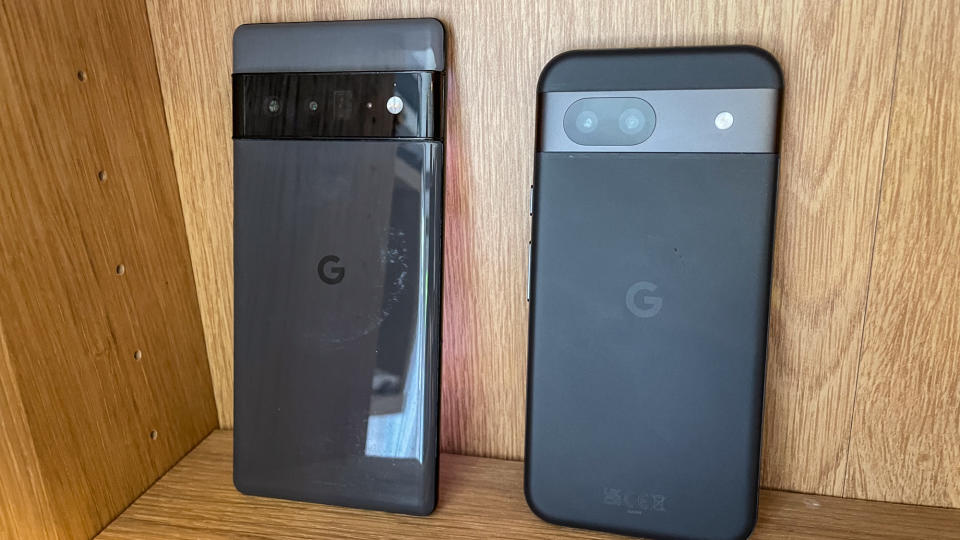
Battery life is one of those things Google has struggled with in recent phone releases. Howver, the Pixel 8a manages to buck that trend, lasting 11 hours and 21 minutes in our custom battery test. That’s not quite enough to score it a place on our best phone battery life list, but it’s closer than any Pixel phone has managed in a long time. It's also about 1.5 hours longer than the average smartphone lasts on our tests.
The Pixel 6 Pro did considerably worse, lasting 7 hours and 49 minutes with its adaptive refresh rate switched on — and 7 hours 55 locked at 60 Hz. That was with more than 500 mAh of extra battery capacity as well, which shows just how far Google has come in the past couple of years.
The Pixel 6 Pro has an advantage in terms of charging, with a maximum charging speed of 22W compared to the Pixel 8a’s 18W. In our testing we found that the Pixel 6 Pro regained 20% charge in 15 minutes, and hit 40% after half an hour. Meanwhile the Pixel 8a only managed to hit 16% after 15 minutes and 33% after 30 minutes. It’s only a slight difference, as Google's phones charge pretty slowly compared to their Android rivals.
Considering the Pixel 8a lasts a lot longer than the Pixel 6 Pro, I’d say it certainly has the advantage in the battery department.
Google Pixel 8a vs Pixel 6 Pro: Software
Software is where things get a little tricky. The Google Pixel 8a comes with a Tensor G3, which offers a number of AI features, including photo editing capabilities. These are some of the most common AI features you’ll use, but it seems like everything the Pixel 8a offers is still available on Pixel 6 Pro in one way or another.
Newer AI photo editing capabilities are available through Google Photos, and without some of the limitations imposed on non-Pixel phones. Recent features like Circle to Search are also available on older handsets, as are call-centric features like Hold for Me, Call Screen and so on.
Of course the Tensor G3 is still more advanced than the Tensor G1, and that means the Pixel 8a does have an advantage when it comes to other Tensor-centric benefits — things like computational photography, translation and so on. While you may not notice it as a casual user, there is a more sophisticated system running on the newer phones despite the fact it’s a midrange A-series.
The real noticeable difference is that the Pixel 8a is getting 7 years of full software support from Google. That means it’ll get full Android and security updates until May 2031. Meanwhile the Pixel 6 Pro is set to lose access to Android updates this October, and will get its last regular security update in October 2026. So the Pixel 8a is going to last a lot longer than the Pixel 6 Pro would have.
While this doesn’t stop you continuing to use the 6 Pro for at least a couple more years, you will miss out on any additional software features Android receives after the initial rollout of Android 15.
Google Pixel 8a vs Google Pixel 6 Pro: Outlook
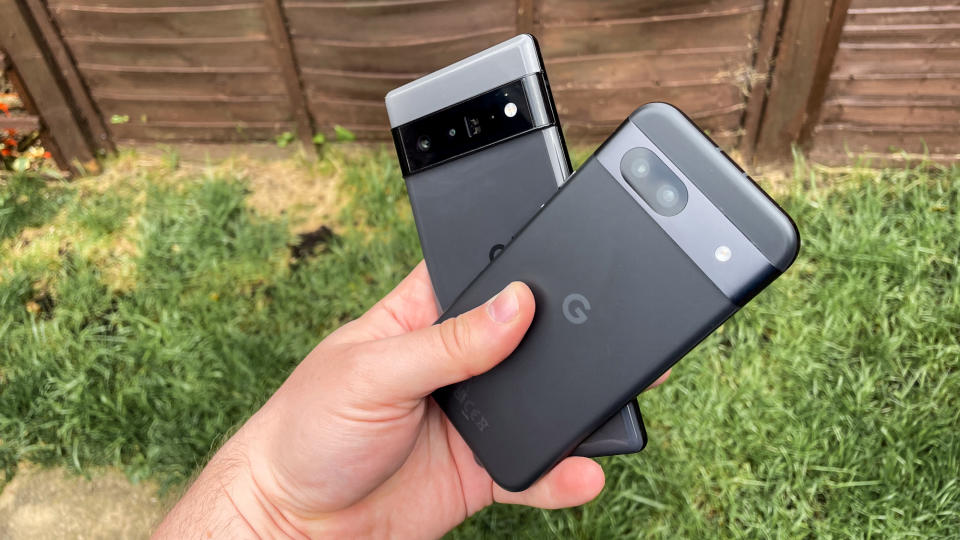
While switching from a Pro series Pixel to an A-series might not seem like much of an upgrade, you do have to consider just how much Google stuffs into its midrange phones. In fact, the Pixel 8a is our top pick for the best cheap phone right now, and casual observers might struggle to notice the difference between this and a more expensive premium model.
While you may be tempted to wait for the flagship Pixel 9 Pro, you can’t go wrong upgrading to the Pixel 8a righ now. You won’t get Pro features like the telephoto zoom, or premium design features like super-slim bezels, but you will get a feature-packed device for a fairly low price tag. The Pixel 8a also offers impressive battery life, improved performance and produces better photos than past Pixels — not to mention the sweet 7 years of software support.

